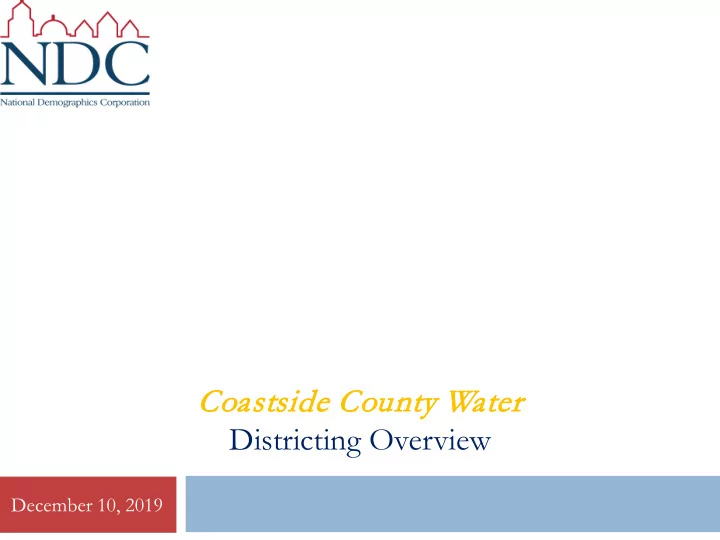

Coast stsi side County ty Wate ter Districting Overview December 10, 2019
California Voting Rights Act (CVRA) 2 Under the Federal Voting Rights Act (passed in 1965), a jurisdiction must fail 4 factual tests before it is in violation of the law. The California VRA makes it significantly easier for plaintiffs to force jurisdictions into “by-district” election systems by eliminating two of the US Supreme Court Gingles tests: (crossed-out tests are Federal Tests that plaintiffs no longer have to prove to show a violation of the California law) Can the protected class constitute the majority of a district? 1. Does the protected class vote as a bloc? 2. Do the voters who are not in the protected class vote in a bloc to defeat the preferred 3. candidates of the protected class? Do the “totality of circumstances” indicate race is a factor in elections? 4. Liability is now determined only by a statistical test for a correlation (not causation) between ethnicity and voting December 10, 2019
CVRA Governance Impact 3 Switched (or in the process of switching) as a result of CVRA: At least 215 school districts 34 Community College Districts 126 cities For comparison, before passage of CVRA only 29 California cities used by-district elections. With all of the CVRA-driven changes we have gone from 29 to over 150 cities 1 County Board of Supervisors 35 water and other special districts. December 10, 2019
Tentative Districting Timeline 4 Step Description Two Initial Hearings Held prior to release of draft maps. Dec. 10 and 17 Education and to solicit input on the communities in the City. Hearings on Draft Maps Two meetings to discuss and revise the draft maps Jan. 14 and 28 and to discuss the election sequencing. Final Hearing and Final public hearing; selection of map and election year sequence; Adoption Board adoption. Feb. 11 Election Day: First by-division elections held. November 2020 Adjust Maps: Map adjusted using 2020 Census data 2021 Election Day: First by-division election held in remaining divisions. November 2022 December 10, 2019
Districting Rules and Goals 5 Federal Laws Traditional Redistricting Principles Communities of interest Equal Population Compact Federal Voting Rights Act Contiguous No Racial Gerrymandering Visible (Natural & man-made) boundaries Respect voters’ choices / continuity in office Planned future re g gro rowth (2021 co consider ideratio ion) December 10, 2019
Defining Communities of Interest 6 1 st Question: what is your neighborhood or community of interest? A Community of Interest is generally defined as a neighborhood or community of shared interests, views, problems, or characteristics. Possible community feature/boundary definitions include: School attendance areas Natural neighborhood dividing lines, such as highway or major roads, rivers, canals, and/or hills Areas around parks and other neighborhood landmarks Common issues, neighborhood activities, or legislative/election concerns Shared demographic characteristics Such as similar levels of income, education, or linguistic isolation December 10, 2019
Defining Communities of Interest 7 2 nd Question: Does a Community of Interest want to be united in one district, or to be divided to have a voice in multiple elections? December 10, 2019
Sample Compact Maps 8 Compton Glendale Unified Examples of highly compact maps that keep regions and communities united, with nooks and jogs driven only by equal population requirements. December 10, 2019
Sample Multiple-Representative Maps 9 Pasadena Colorado Blvd. Examples of maps where a desire Central Unified to have all members touch downtown (Pasadena) or rural areas (Central), or as many neighborhoods as possible (South Pas), led to policy-driven but non-compact maps. December 10, 2019
Discussion 10 What is your neighborhood or “community of interest”? 1. Do you prefer your neighborhood be kept together in one 2. trustee area, or have multiple representatives? December 10, 2019
Recommend
More recommend